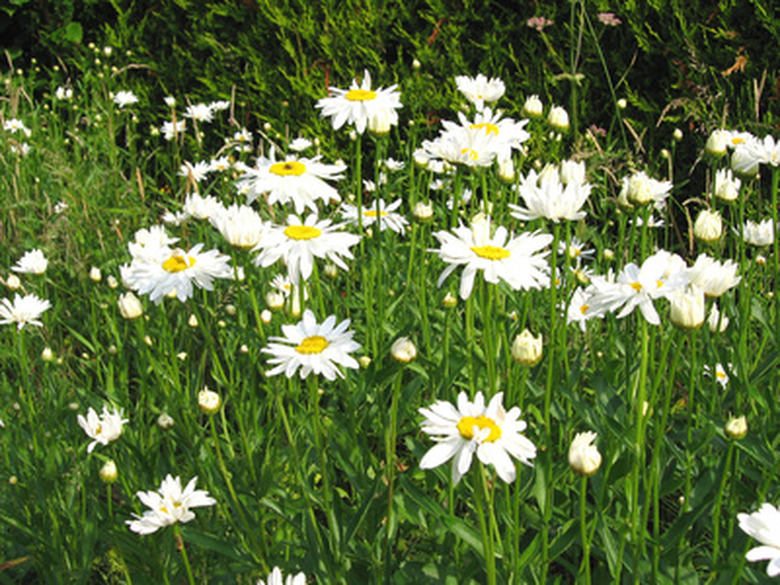The Growing Stages Of A Shasta Daisy Plant
Shasta daisies (Chrysanthemum maximum) are perennials that bloom from May to October and are often used as border plants. Shasta daisies can grow to 4 feet tall and have white blooms that are up to 4 inches across; they may have single, double, quilled or shaggy blooms. Shasta daisies are hardy in nearly every climate, except for the most hot and humid (Florida or far South Texas, for example). They thrive in full sun with regular water.
Seedlings
Shasta daisies may be sowed from seed in the ground, and should be planted in spring, when ground is workable in coldest regions. Place the seed approximately 1/16 inch below the surface and water regularly until germination. Seeds may take up to four weeks to germinate, and when the seedling breaks through the ground, it will have tiny leaves on a thin stem.
- Shasta daisies (Chrysanthemum maximum) are perennials that bloom from May to October and are often used as border plants.
- Shasta daisies may be sowed from seed in the ground, and should be planted in spring, when ground is workable in coldest regions.
First Year
Once the seedling has begun to develop, coarse, leathery leaves will begin to form, and the plant will grow up as well as out. Shasta daisies are clumping perennials, and as the plant matures, the roots will begin to spread underground. Through the first year, foliage will grow fairly rapidly, but it is unlikely that the plant will flower.
Blooms
After Shasta daisies are established, they should bloom in summer and fall. Individual flower stems will grow from the clump of foliage, and each stem will bear a single flower, which begins as a tight, small ball but opens into a white, multi-petaled bloom, usually with a yellow center. Blooms are long lasting and vary in size.
End of Bloom Cycle
When blooms are spent, they should be removed. You may deadhead the plants by pinching the bloom off the stem. This will promote more blooms and prevent the plant from re-seeding. If you prefer, you may leave the spent blooms and the seeds will mature and drop, creating more plants. Another option is collecting the seeds for use in another spot. If you want to collect seeds, cut the spent blooms, and dry them by hanging flowers upside down. When flowers are dry, crush the blooms to remove seeds.
- Once the seedling has begun to develop, coarse, leathery leaves will begin to form, and the plant will grow up as well as out.
- Shasta daisies are clumping perennials, and as the plant matures, the roots will begin to spread underground.
Mature plants may be divided every two to three years.
References
- "Sunset National Garden Book"; the editors of Sunset Books and Sunset Magazine; 1997
- Aggie Horticulture: Shasta Daisy
